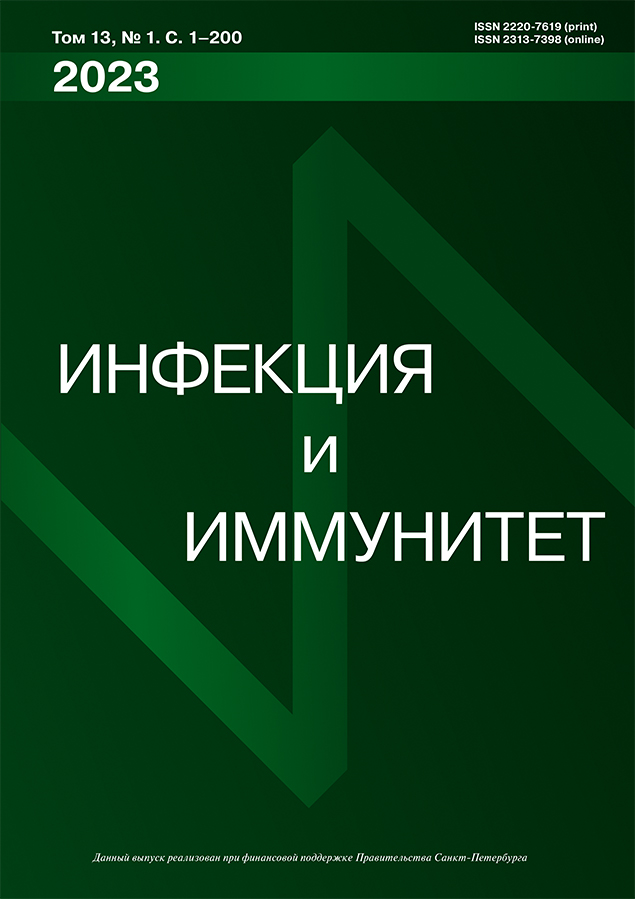Метод селективного выделения Acinetobacter baylyi из речной воды
- Авторы: Сиволодский Е.П.1,2, Краева Л.А.1,2, Мельникова Е.В.1
-
Учреждения:
- ФГБВОУ ВО Военно-медицинская академия имени С.М. Кирова МО РФ
- ФБУН НИИ эпидемиологии и микробиологии имени Пастера
- Выпуск: Том 13, № 1 (2023)
- Страницы: 191-196
- Раздел: МЕТОДЫ
- URL: https://bakhtiniada.ru/2220-7619/article/view/126050
- DOI: https://doi.org/10.15789/2220-7619-MOS-2112
- ID: 126050
Цитировать
Полный текст
Аннотация
Цель исследования — повышение селективности выделения бактерий Acinetobacter baylyi из речной воды. При разработке селективной среды использовали 5 штаммов A. baylyi, из них 4 были выделены из воды реки Невы, 1 — из клинического материала. Штаммы A. baylyi идентифицировали по комплексу фенотипических признаков и/или с помощью масс-спектрометрического метода (MALDI-ToF MS). В предварительных исследованиях было установлено, что бактерии A. baylyi не утилизируют L-фенилаланин в качестве единственного источника углерода и азота, а также в качестве единственного источника углерода на среде с минеральными источниками азота, но утилизируют L-фенилаланин в качестве единственного источника только азота, если он дополняется этанолом в качестве единственного источника углерода. На основе этого свойства A. baylyi была разработана селективная среда для выделения этих бактерий из речной воды. Состав и приготовление жидкой селективной среды: в 1 л дистиллированной воды вносят (г/л) L-фенилаланин (CAS 63-91-2) 2,0; NaCI 5,0; Na2SO4 2,0; KH2PO4 1,0; K2HPO4 2,5; MgSO4 0,1; растворяют при нагревании, кипятят 5 мин, добавляют в теплую среду 4 мл 96-градусного этанола, проверяют рН 7,2±0,2; разливают по 40 мл в стерильные флаконы. Плотная селективная среда: содержит на 1 л дистиллированной воды те же ингредиенты и дополнительно 15,0 г агара; приготовление такое же, среду разливают в стерильные чашки Петри. Методика применения селективной питательной среды для выделения A. baylyi из речной воды: воду реки Невы засевают в объеме 10 мл во флакон с 40 мл жидкой селективной среды, инкубируют в аэробных условиях при 28°С 48 ч, затем пересевают бактериологической петлей обогащенный материал из флакона на поверхность плотной селективной среды такого же состава в две чашки; инкубируют посевы в аэробных условиях при 28°С 48 ч. Отбирают для последующей идентификации по 10 изолированных колоний, пересевают их на секторы питательного агара, инкубируют при 28°С 24 ч и идентифицируют изоляты по комплексу фенотипических признаков, характерных для A. baylyi, и/или методом MALDI-ToF MS. В данном примере из 20 выделенных изолятов 19 являлись бактериями A. baylyi (95% изолятов). Исследование по указанной методике еще трех проб воды из реки Невы показали результаты одинаковой узкоселективной направленности — 90–95% изолятов составляли бактерии A. baylyi.
Полный текст
Открыть статью на сайте журналаОб авторах
Евгений Петрович Сиволодский
ФГБВОУ ВО Военно-медицинская академия имени С.М. Кирова МО РФ; ФБУН НИИ эпидемиологии и микробиологии имени Пастера
Email: lykraeva@yandex.ru
д.м.н., профессор кафедры микробиологии; старший научный сотрудник лаборатории молекулярно-биологических технологий
Россия, Санкт-Петербург; Санкт-ПетербургЛюдмила Александровна Краева
ФГБВОУ ВО Военно-медицинская академия имени С.М. Кирова МО РФ; ФБУН НИИ эпидемиологии и микробиологии имени Пастера
Автор, ответственный за переписку.
Email: lykraeva@yandex.ru
д.м.н., зав. лабораторией медицинской бактериологии; профессор кафедры микробиологии
Россия, Санкт-Петербург; Санкт-ПетербургЕлена Владимировна Мельникова
ФГБВОУ ВО Военно-медицинская академия имени С.М. Кирова МО РФ
Email: lykraeva@yandex.ru
врач-бактериолог лаборатории бактериологии Центральной клинико-диагностической лаборатории
Россия, Санкт-ПетербургСписок литературы
- Патент № 2769434 Российская Федерация. МПК C12N 1/20 (2006.01), C12Q 1/04 (2006.01), C12R 1/01 (2006). Способ выделения бактерий вида Acinetobacter baylyi из речной воды; № 2021130073, заявлено 2021.10.14, опубликовано 2022.03.31 / Сиволодский Е.П. Патентообладатель: Сиволодский Евгений Петрович. 6 с. [Patent No 2769434 Russian Federation, Int.Cl. C12N 1/20 (2006.01), C12Q 1/04 (2006.01), C12R 1/01 (2006/01). Method for isolation of Acinetobacter baylyi from river water; № 2021130073, application 2021.10.14; date of publication 2022.03.31 / Sivolodskij E.P. Proprietors Sivolodskij Evgenij Petrovich. 6 p. (In Russ.)]
- Сиволодский Е.П., Горелова Г.В., Богословская С.П., Зуева Е.В. Селективная синтетическая питательная среда «Ацинетобактер фенилаланин агар» для выделения и идентификации бактерий комплекса Acinetobacter calcoaceticus –Acinetobacter baumannii // Инфекция и иммунитет. 2020. Т. 10, № 5. С. 591–596. [Sivolodskii E.P., Gorelova G.V., Bogoslovskaja S.P., Zueva E.V. Selective syntetic growth medium «Acinetobacter phenylalanine agar» for isolation and identification of Acinetobacter calcoaceticus–Acinetobacter baumannii complex species. Infektsiya i immunitet = Russian Journal of Infection and Immunity, 2020, vol. 10, no. 3, pp. 591–596. (In Russ.)] doi: 10.15789/2020-7619-ASS-1177
- Carr E.L., Kampfer P., Patel B.K.C., Gurtler V., Seviour R.J. Seven novel spesies of Acinetobacter isolated from activated sludge. Int. J. Syst. Evol. Microbiol., 2003, vol. 53, no. 4, pp. 953–963. doi: 10.1099/ijs.0.02486-0
- Chen T.L., Siu L.K., Lee Y.T., Chen C.H., Huang L.Y., Wu R.C., Cho W.L., Fung C.P. Acinetobacter baylyi as a pathogen for opportunistic infection. J. Clin. Microbiol., 2008, vol. 46, no. 9, pp. 2938–2944. doi: 10.1128/JCM.00232-08
- Krizova L., Maixnerova M., Sedo O., Nemec A. Acinetobacter albensi sp. nov., isolated from natural soil and water ecosystems. Int. J. Syst. Evol. Microbiol., 2015, vol. 65, no. 11, pp. 3905–3915. doi: 10.1099/ijs.0.00051
- Suarez G.A., Dugan K.R., Renda B.A., Leonard S.P., Gangavarapu L.S., Barrick J.E. Rapid and assured genetic engineering methods applid to Acinetobacter baylyi ADPI genome streamlining. Nucleic Acids Res., 2020, vol. 48, no.8, pp. 4505–4600. doi: 10.1093/nar/gkaa204
- Zhou Z., Du X., Wang L., Yang Q., Fu Y., Yu Y. Clinical carbapenem-resistant Acinetobacter baylyi strain coharboring blaSIM-1 and blaOXA-23 from China. Antimicrob. Agents Chemother., 2011, vol. 55, no. 11, pp. 5347–5349. doi: 10.1128/AAC.00425-11
Дополнительные файлы







